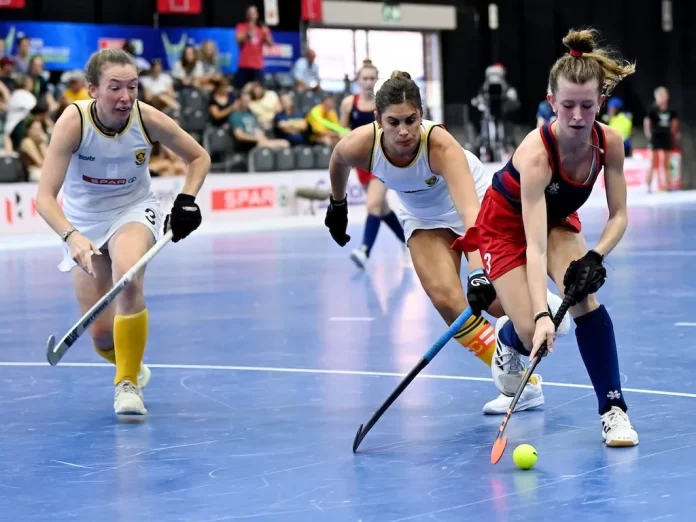Why India does not play Indoor hockey
The recently concluded Hockey India League (HIL) drew 40 million viewers, showing that field hockey still has a strong fanbase in India. But there’s another version of the game that hasn’t caught on—indoor hockey.
The 2025 Indoor Hockey World Cup was held in Poreč, Croatia, from February 3 to 9. It was a major international event, but it received almost no attention in India. No viewership numbers, no trending headlines.
Which brings us to a simple question: Why doesn’t India play indoor hockey?
What Is Indoor Hockey?
Indoor hockey is a shorter, faster version of field hockey. It’s played on a hard indoor surface, with six players per team. The game uses sideboards to keep the ball in play, and the ball can only be lifted when shooting at the goal.
It’s high-paced, skill-heavy, and exciting to watch.
| Feature | Field Hockey | Indoor Hockey |
|---|---|---|
| Playing Surface | Astroturf | Hard(wood, synthetic, vinyl) |
| Team Size | 11 | 6 |
| Ball Movement | Aerials allowed | Ball must stay on ground |
| Match Duration | 60 mins (4*15 mins) | 40 mins (2*20 mins) |
| Game Speed | Fast with more space | Faster than field hockey |
| Side Boards | None, ball goes out of play | Yes, keeps the ball in play |
What Experts Say
To dig deeper, we spoke with indoor hockey experts. While there isn’t one single reason, a few clear patterns explain India’s absence from the sport.
Indoor hockey is common in countries with harsh winters or limited outdoor space. It also needs proper indoor facilities—which not every country invests in—especially when field hockey is the main focus.
The Origins of Indoor Hockey
Different parts of the world have different origin stories for indoor hockey. In Europe, organizers introduced indoor hockey to ensure year-round play. Harsh winters froze outdoor pitches, often forcing cancellations of games. Even today, social media discussions highlight how frozen pitches disrupt outdoor games in Europe.
To keep players fit and engaged during winter, Germany introduced indoor hockey in the early 1950s. In 1955, the German Hockey Federation (DHB) created rules for indoor hockey, and in 1956, Frankfurt hosted the first indoor hockey tournament.
Indoor Hockey In Australia
Australia does not experience harsh winters like Europe, with temperatures ranging between 15 and 30 degrees Celsius. So, how did indoor hockey catch on in Australia?
According to Jerome from Blue Sky Sports International, the Australian Navy played a key role in introducing the sport to Australia. During World War II, naval officers played a form of hockey on ships called deck hockey. Using polo-style sticks and pucks (similar to ice hockey), they played on the deck to stay fit and active while stationed on warships.

The popularity of deck hockey led to the creation of a shorter version of the game after World War II. By the 1970s, the sport gained traction, and in 1979, Australia hosted its first official Indoor Hockey Championships.
The different origins of indoor hockey explain why the sport never gained traction in India. The country’s history and economic conditions played significant roles.
Read More: The Mystery of Hockey: Massive Fandom, Stagnant Revenue
Why India Never Adopted Indoor Hockey
1. Timing and Introduction
The British introduced field hockey in India in the 19th century, and the first recorded match took place in 1885. Like cricket, hockey gained popularity as Indians embraced it as their own. India’s three most popular sports—cricket, football, and hockey—share a common origin: British influence.
By the time India gained independence in 1947, there was no sign of indoor hockey, the sport emerging only in the 1950s and 1960s. It didn’t exist during the colonial period, and never got introduced post India’s independence.
2. No Need for Indoor Hockey
Indoor hockey became popular in Europe to combat frozen pitches during harsh winters. India, however, never faced this issue. While some regions experience cold winters, most of the country enjoys pleasant weather that allows year-round field hockey. Without frozen pitches, India had no need for an indoor version of the game to keep players fit and trained.
3. Economic Constraints and Playing Catch-Up
Economic factors significantly influence sports development, and hockey in India was no exception. After gaining independence in 1947, India struggled economically and focused on rebuilding the nation.
India initially dominated hockey, but the introduction of Astroturf changed the game from a skill-based sport to one requiring greater physical power. Wealthier nations adapted quickly, but India, facing financial difficulties, struggled to keep up. Investing in a new form of hockey like indoor hockey became an afterthought as the country prioritized modernizing its field hockey infrastructure.
Conclusion
Europe and Australia turned to indoor hockey because of weather, history, and need. India didn’t have the same conditions. With good weather for outdoor play, limited funding, and the challenge of modernizing field hockey, indoor hockey never found a place here.
Maybe one day that will change. But for now, India’s focus remains on the original version of the game—played under the open sky, where it all began.
Update: This is a revised version of the article I shared two days ago. I’ve added new sections, fixed the flow, and included better context—thanks for reading again if you’re back!
P.S. Huge thanks to Jerome from Blue Sky Sports International for patiently sharing the history of indoor hockey in Australia. This article took over two years to come together—no excuse for the delay, just an honest apology. You deserved better. Thank you again.





